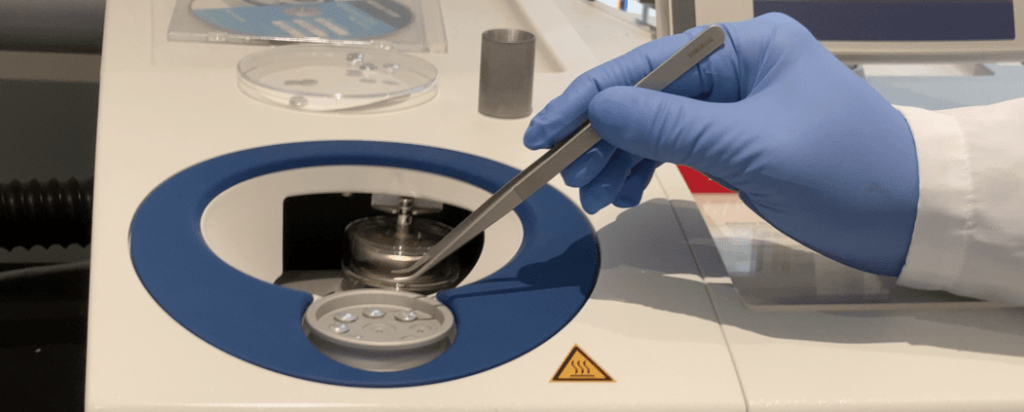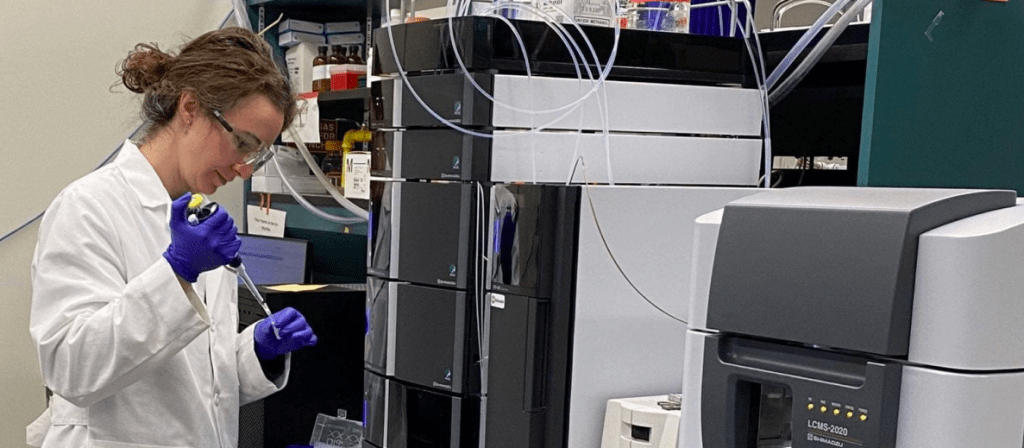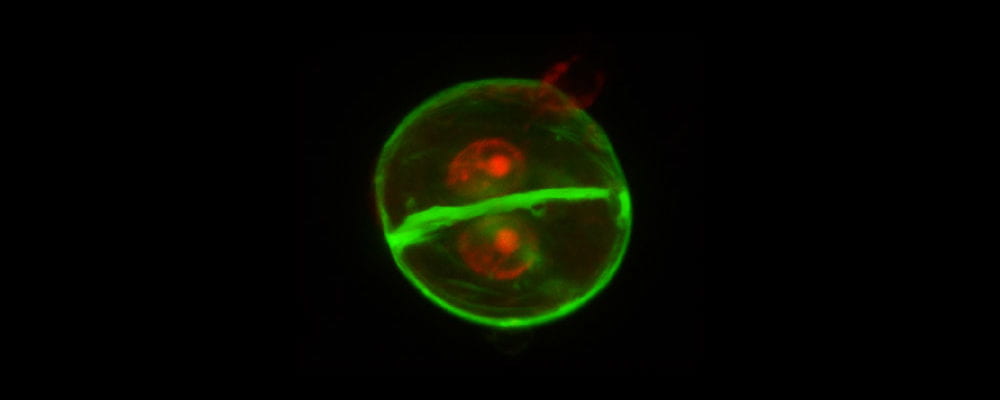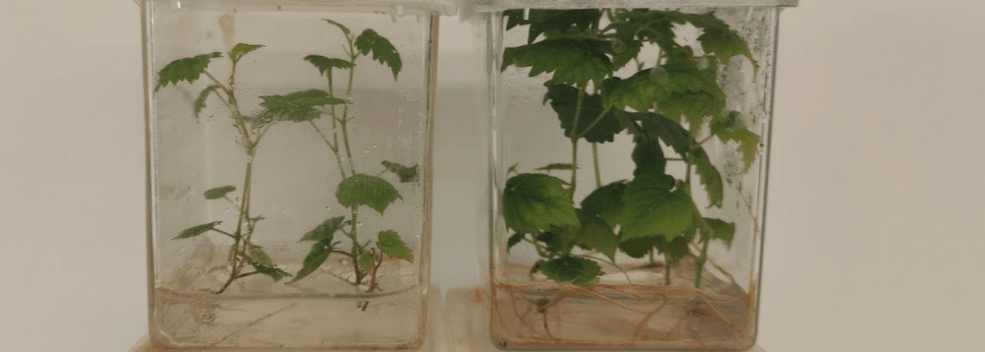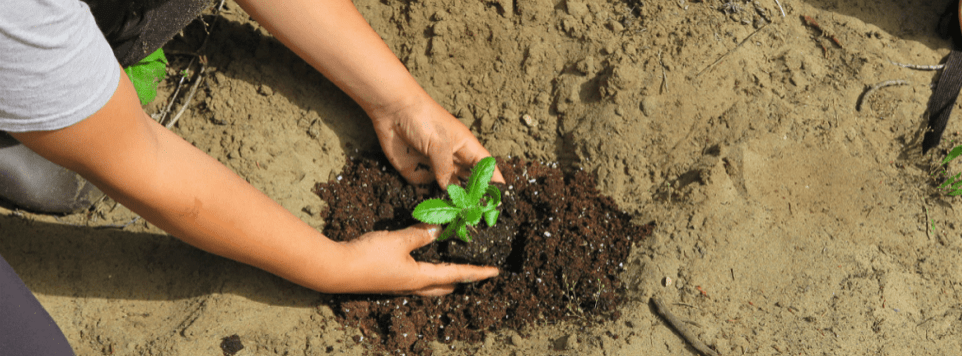GRIPP develops multifaceted research programs to advance conservation of plant biodiversity.
GRIPP interdisciplinary research programs utilize technologies of plant tissue culture, cryobiology, chemistry, molecular biology, physiology and integrated plant production systems to provide science-based solutions for preventing the loss of plant biodiversity and enhancing agriculture.
GRIPP programs aim to advance knowledge of in vitro technologies for conservation and re-establishment of threatened species and extend their applications in forestry, food security, plant medicines and horticulture.
In addition to maintaining an in vitro germplasm collection, GRIPP researchers are investigating fundamental questions related to mechanisms of resistance to diseases, abiotic and biotic stresses, as well as, plant responses to changing environments.
Chemistry
GRIPP is currently researching how specific plant growth regulators (PGRs) mediate growth and development processes and protect plants against environmental stresses including cold, UV, and toxic ions. Endogenous profiles of PGRs are determined by using ultra performance liquid chromatography and mass spectrometry (UPLC-MS). Prior knowledge of endogenous PGRs in plant tissues facilitates the application of in vitro technology for propagating recalcitrant-to-regenerate plant species.
Selected Publications
Ayyanath MM, Shukla MR, Sriskantharajah K, Hezema YS, Saxena PK (2024). Stable indoleamines attenuate stress – A novel paradigm in tryptophan metabolism in plants. J Pineal Res, 76(2), e12938.
Ayyanath MM, Shukla MR, Hezema YS, and Saxena, PK (2023). Straw Mulch Induced Indoleamines Alleviate Reproductive Depression in Cold Sensitive Hazelnut Cultivars. Plants, 12(13), 2577.
Ayyanath MM., Shukla MR, and Saxena PK (2023). Indoleamines Impart Abiotic Stress Tolerance and Improve Reproductive Traits in Hazelnuts. Plants, 12(6), 1233.
Kulak, V., Longboat, S., Brunet, N. D., Shukla, M., & Saxena, P. (2022). In Vitro Technology in Plant Conservation: Relevance to Biocultural Diversity. Plants, 11(4), 503.
Bi W, Saxena A, Ayyanath MM, Harpur C, Shukla MR and Saxena PK (2021) Conservation, Propagation, and Redistribution (CPR) of Hill’s thistle – Paradigm for plant species at risk. Plant Cell, Tissue and Organ Culture, 145, 75-88
Ayyanath MM, Shukla MR and Saxena PK (2021) Role of water percolation in reproductive physiology of hazelnut (Corylus spp.). Environmental and Experimental Botany, 182, p.104278
Erland LAE, Giebelhaus RT, Victor JMR, Murch SJ, Saxena PK (2020) The morphoregulatory role of Thidiazuron: Metabolomics-guided hypothesis generation for mechanisms of activity. Biomolecules10, 1253
Erland LAE Saxena PK. (2019) Auxin driven indoleamine biosynthesis and the role of tryptophan as an inductive signal in Hypericum perforatum (L.). PLoS ONE, 14, e0223878
Erland LA, Yasunaga A, Li I, Murch SJ, Saxena PK (2019) Direct visualization of location and uptake of applied melatonin and serotonin in living tissues and their redistribution in plants in response to thermal stress. J. Pineal Research, 66, e12527
Erland LAE, Shukla MR, Singh AS, Murch SJ, Saxena PK (2018) Melatonin and serotonin: Mediators in the symphony of plant morphogenesis. J. Pineal Research, 64, e12452
Cryobiology
Our research on the application of in vitro technologies in recovery of species at risk has introduced an integrated approach of conservation and a model referred to as the CPR (Conservation, Propagation and Redistribution). The CPR utilizes cryopreservation which allows storge of living tissues at ultra-low temperatures (−196 °C) in frozen state until needed to be revived and propagated for replenishing lost or severely threatened populations. The CPR model has been successfully used to enhance natural populations of threatened plant species in areas suffering from population decline.
In addition to ‘backing-up’ plant biodiversity ex-situ, cryopreservation ensures the long-term sustainability and security of economically important crops. Since 2014, GRIPP has continued to preserve endangered and economically important species from across the globe in its Cryobank. To date, cryopreservation protocols have been developed for a variety of species including American elm, American chestnut, cherry birch, ginseng, lupine, golden paintbrush, Hill’s thistle, Mingan’s thistle, Yukon Draba, St. John’s Wort, Chrysanthemum, and many others.
Selected Publications
Liu Z, Bi WL, Shukla MR, Saxena PK (2022) In Vitro Technologies for American Chestnut (Castanea dentata (Marshall) Borkh) Conservation. Plants, 11, p.464
Saxena A, Bi W-L, Shukla MR, Cannings S, Bennett B and Saxena PK (2021) Micropropagation and cryopreservation of Yukon Draba (Draba yukonensis), a special concern plant species endemic to Yukon Territory, Canada. Plants, 10, p.2093
Valdés YC, Shukla MR, Vega MEG and Saxena PK (2021) Improved conservation of coffee (Coffea arabica L.) germplasm via micropropagation and cryopreservation. Agronomy, 11, p.1861
Wang M-R, Bi W-L, Shukla MR, Ren L, Hamborg Z, Blystad D-R, Saxena PK and Wang Q-C (2021) Epigenetic and genetic integrity, metabolic stability, and field performance of cryopreserved plants. Plants, 10, p.1889
Bi W, Saxena A, Ayyanath MM, Harpur C, Shukla MR and Saxena PK (2021) Conservation, Propagation and Redistribution (CPR) of Hill’s thistle – Paradigm for plant species at risk. Plant Cell, Tissue and Organ Culture, 145, 75-88
Popova E, Shukla MR, McIntosh T and Saxena PK (2021) In vitro and cryobiotechnology approaches to safeguard Lupinus rivularis Douglas ex Lindl., an endangered plant in Canada. Agronomy, 11, p.37
Sheikholeslami B, Shukla M, Turi C, Harpur C and Saxena, PK (2020) Saving threatened plant species: Reintroduction of Hill’s thistle (Cirsium hillii (Canby) Fernald) to its natural habitat. PLoS ONE, 15, p.e0231741
Popova E, Shukla MR, Kim H and Saxena PK (2020) Root cryobanking: an important tool in plant cryopreservation. Plant Cell, Tissue and Organ Culture, 144, pp.49-66
Yang X, Popova E, Shukla MR and Saxena PK (2019) Root cryopreservation to biobank medicinal plants: a case study for Hypericum perforatum L. In Vitro Cellular & Developmental Biology – Plant, 55, pp.392-402
Popova E, Kim HH, Saxena PK, Engelmann F, Pritchard HW (2016) Frozen beauty: The cryobiotechnology of orchid diversity. Biotechnology advances, 34, pp.380-403.
Physiology
Understanding the physiology of plant growth and development in vitro and in vivo under normal and challenging environments is crucial for effective conservation, sustainable use, restoration, and replenishment of threatened plant species in their natural environments. Our research focuses on the role of a novel class of plant growth regulators, the indoleamines melatonin and serotonin, in the regulation of plant morphogenesis, modulation of plant metabolism in changing climates and adaptations to multiple stress conditions.
Selected Publications
Vongnhay V, Shukla MR, Ayyanath MM, Sriskantharajah K, Saxena PK (2024). In Vitro Morphogenesis of Tobacco: Modulation of Endogenous Growth Regulators by Tulsi (Holy Basil). Plants, 13(14), 2002.
Vongnhay V, Shukla MR, Ayyanath MM, Sriskantharajah K, Saxena PK (2024). Enhanced In Vitro Plant Morphogenesis of Tobacco: Unveiling Indoleamine-Modulated Adaptogenic Properties of Tulsi (Ocimum sanctum L.). Plants, 13(10),1370.
Ayyanath MM, Shukla MR and Saxena PK (2021) Role of water percolation in reproductive physiology of hazelnut (Corylus spp.). Environmental and Experimental Botany, 182, p.104278
Shukla MR, Bajwa VS, Freixas-Coutin JA and Saxena PK (2021) Salt stress in Arabidopsis thaliana seedlings: Role of indoleamines in stress alleviation. Melatonin Research, 4, pp70-83
Hezema YS, Shukla MR, Goel A, Ayyanath MM, Sherif SM and Saxena PK (2021) Rootstocks Overexpressing StNPR1 and StDREB1 Improve Osmotic Stress Tolerance of Wild-Type Scion in Transgrafted Tobacco Plants. International journal of molecular sciences, 22, p.8398
Sriskantharajah K, El Kayal W, Torkamaneh D, Ayyanath MM, Saxena PK, Sullivan AJ, Paliyath G and Subramanian J (2021) Transcriptomics of Improved Fruit Retention by Hexanal in ‘Honeycrisp’ Reveals Hormonal Crosstalk and Reduced Cell Wall Degradation in the Fruit Abscission Zone. International journal of molecular sciences, 22, p.8830
Hezema YS, Shukla MR, Ayyanath MM, Sherif SM and Saxena PK (2021) Physiological and Molecular Responses of Six Apple Rootstocks to Osmotic Stress. International Journal of Molecular Sciences, 22, p.8263
Chattopadhyay A, Erland LAE, Jones AMP, Saxena PK. (2018) Indoleamines and phenylpropanoids modify plant development in the bryophyte Plagiomnium cuspidatum (Hedw.) TJ Kop. In Vitro Plant Cellular and Developmental Biology – Plant. 54, pp.454-64
Sherif SM, Erland LAE, Shukla MR, Saxena PK (2017) Bark and wood tissues of American elm exhibit distinct responses to Dutch elm disease. Scientific Reports (Nature). 7, p.7114
Sherif SM, Shukla MR, Murch SJ, Bernier L, Saxena PK (2016) Simultaneous induction of jasmonic acid and disease-responsive genes signifies tolerance of American elm to Dutch elm disease. Scientific Reports (Nature). 6, p.21934
Tissue Culture
Plant tissue culture is a technique used to grow plants under sterile conditions in order to gain greater control over plant growth and development. Plant tissue culture involves taking a small piece or cutting of a plant (also known as the explant) and growing it in a semisolid or liquid medium containing necessary nutrients and hormones which are required for ensuring healthy plant growth.
GRIPP scientists use plant tissue culture for many purposes including to conserve endangered or threatened plants ex-situ, clonally propagate plants using a process known as micropropagation, and to study plant growth responses such as disease resistance and adaptations in changing climates.
GRIPP currently maintains an in vitro germplasm collection comprised of over 100 species from around the globe, including a variety of endangered medicinal plants and native Canadian plants. Some of the species currently being investigated include native trees such as American elm, American chestnut, maple, oak, ash, and cherry birch, and many ornamental and medicinal plants including orchids, holy basil, goldenseal, and St John’s Wort.
Selected Publications
Kulak V, Longboat S, Brunet ND, Shukla MR, Saxena PK (2022) In Vitro Technology in Plant Conservation: Relevance to Biocultural Diversity. Plants, 11, p.503
Nicholson J, Shukla MR and Saxena PK (2020) In vitro rooting of hybrid hazelnuts (Corylus avellana × Corylus americana) in a temporary immersion system. Botany, 98, pp.343-52
Salama A, Shukla MR, Popova E, Fisk N, Jones AMP, Saxena PK. (2018) In vitro propagation and re-introduction of Golden Paintbrush (Castilleja levisecta), a critically imperiled plant species. Canadian Journal of Plant Science, 98, 762-70
Rathwell R, Shukla M, Jones M, Saxena PK. (2016). In vitro propagation of cherry birch (Betula lenta L.). Canadian Journal of Plant Science. 96(4): 571-578
Shukla MR, Jones AMP, Sullivan JA, Liu C, Gosling S, Saxena PK. (2012). In vitro conservation of American elm (Ulmus americana): potential role of auxin metabolism in sustained plant proliferation. Can. J.For. Res.42: 686-697
Integrated Plant Production Systems
Micropropagation is a plant tissue culture technique commonly employed in the horticultural industry, whereby plant tissues can be multiplied hundreds, if not thousands of times to produce genetically identical clones. Our integrated approach which combines micropropagation and environmentally controlled greenhouse technology has important applications in the rapid production and distribution of threatened and endangered plants by allowing researchers to restore wild populations at risk of extinction at a much quicker rate.
Additionally, controlled environment production offers a unique opportunity for fast introduction of commercially important plants such as novel hybrids, mutants, sports, native species, and plants with improved traits such as unique flower color, disease resistance, altered yield, and higher content of medicinally active compounds.
Selected Publications
Islam MT, Coutin JF, Shukla M, Dhaliwal AK, Nigg M, Bernier L, Sherif SM, Saxena PK (2022) Deciphering the Genome-Wide Transcriptomic Changes during Interactions of Resistant and Susceptible Genotypes of American Elm with Ophiostoma novo-ulmi. J. Fungi, 8, p.120
Bi W, Saxena A, Ayyanath MM, Harpur C, Shukla MR and Saxena PK (2021) Conservation, Propagation, and Redistribution (CPR) of Hill’s thistle – paradigm for plant species at risk. Plant Cell, Tissue and Organ Culture. 145, pp.75-88
Shukla MR, Kibler A, Turi CE, Erland LAE, Sullivan JA, Murch SJ, Saxena PK (2021) Selection and Micropropagation of an Elite Melatonin Rich Tulsi (Ocimum sanctum L.) Germplasm Line. Agronomy, 11, 207
Valdés YC, Shukla MR, Vega MEG and Saxena PK (2021) Improved Conservation of Coffee (Coffea arabica L.) Germplasm via Micropropagation and Cryopreservation. Agronomy, 11, p.1861
Nicholson J, Shukla MR and Saxena PK (2020) In vitro rooting of hybrid hazelnuts (Corylus avellana × Corylus americana) in a temporary immersion system. Botany, 98, pp.343-52
Shukla MR, Piunno K, Saxena PK and Jones AMP (2020) Improved in vitro rooting in liquid culture using a two-piece scaffold system. Engineering Life Science, 20, 126– 132
Shukla DM, Bajwa V, Gajic D, Saxena PK (2020) Quorum sensing inhibition in Vibrio fischeri: An efficient system to assess antibacterial properties of medicinal plants and their volatile compounds. Integrative Food Nutrition and Metabolism, 7, pp1-9
Freixas-Coutin JA, An S, Postman J, Bassil NV, Yates B, Shukla M, Saxena PK (2019) Development of a reliable Corylus sp. reference database through the implementation of a DNA fingerprinting test. Planta, 249, pp.1863-74
Salama A, Shukla MR, Popova E, Fisk N, Jones AMP, Saxena PK. (2018) In vitro propagation and re-introduction of Golden Paintbrush (Castilleja levisecta), a critically imperiled plant species. Canadian Journal of Plant Science, 98, 762-70
Shukla MR, Amritpal SS, Piunno K, Saxena PK, Jones AMP (2017) Application of 3D printing to prototype and develop novel plant tissue culture systems. Plant Methods, 13, 6
Sing AS, Jones AMP, Shukla MR, Saxena PK (2017) High light intensity stress as the limiting factor in micropropagation of sugar maple (Acer saccharum Marsh.). Plant Cell, Tissue and Organ Culture, 129, 209-21
Padmanabhan P, Shukla MR, Sullivan JA, Saxena PK (2017) Iron supplementation promotes in vitro shoot induction and multiplication of Baptisia australis. Plant Cell, Tissue and Organ Culture, 129, 145-52
Rathwell R, Shukla M, Jones M, Saxena PK (2016) In vitro propagation of cherry birch (Betula lenta L.). Canadian Journal of Plant Science, 96, 571-578
Popova E, Moltchanova E, Han SH, Saxena P, Kim DH (2016) Cryopreservation of Prunus padus seeds: emphasising the significance of Bayesian methods for data analysis. Canadian Journal of Forest Research, 46, 766-74 1
